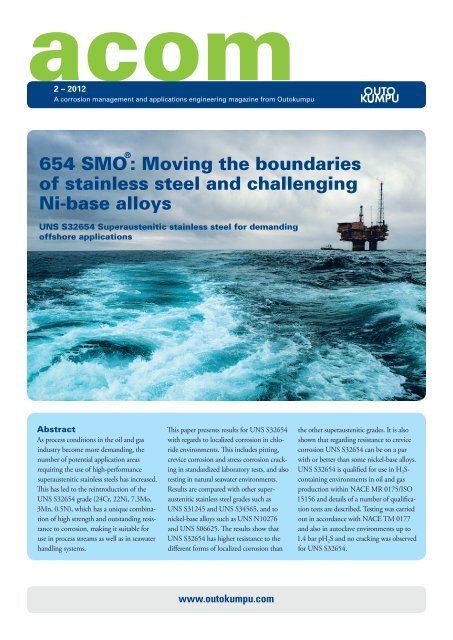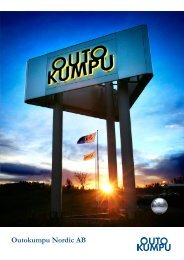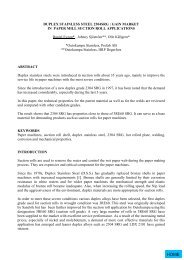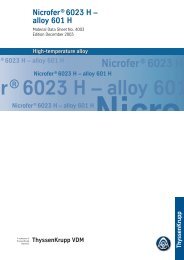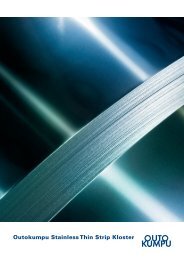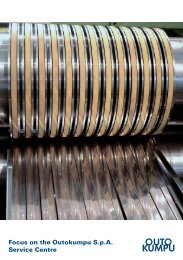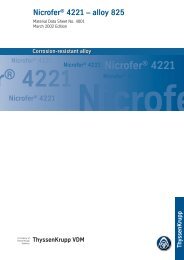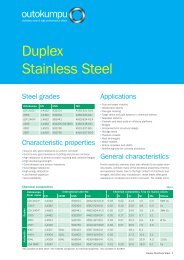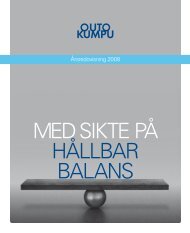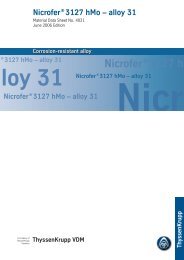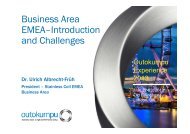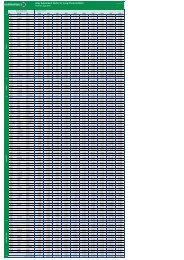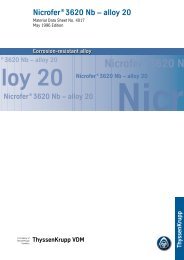654 SMO® Moving the Boundries of Stainless Steel - Outokumpu
654 SMO® Moving the Boundries of Stainless Steel - Outokumpu
654 SMO® Moving the Boundries of Stainless Steel - Outokumpu
You also want an ePaper? Increase the reach of your titles
YUMPU automatically turns print PDFs into web optimized ePapers that Google loves.
acom<br />
2 – 2012<br />
A corrosion management and applications engineering magazine from <strong>Outokumpu</strong><br />
<strong>654</strong> SMO ® : <strong>Moving</strong> <strong>the</strong> boundaries<br />
<strong>of</strong> stainless steel and challenging<br />
Ni-base alloys<br />
UNS S32<strong>654</strong> Superaustenitic stainless steel for demanding<br />
<strong>of</strong>fshore applications<br />
Abstract<br />
As process conditions in <strong>the</strong> oil and gas<br />
industry become more demanding, <strong>the</strong><br />
number <strong>of</strong> potential application areas<br />
requiring <strong>the</strong> use <strong>of</strong> high-performance<br />
superaustenitic stainless steels has increased.<br />
This has led to <strong>the</strong> reintroduction <strong>of</strong> <strong>the</strong><br />
UNS S32<strong>654</strong> grade (24Cr, 22Ni, 7.3Mo,<br />
3Mn, 0.5N), which has a unique combination<br />
<strong>of</strong> high strength and outstanding resistance<br />
to corrosion, making it suitable for<br />
use in process streams as well as in seawater<br />
handling systems.<br />
This paper presents results for UNS S32<strong>654</strong><br />
with regards to localized corrosion in chloride<br />
environments. This includes pitting,<br />
crevice corrosion and stress corrosion cracking<br />
in standardized laboratory tests, and also<br />
testing in natural seawater environments.<br />
Results are compared with o<strong>the</strong>r superaustenitic<br />
stainless steel grades such as<br />
UNS S31245 and UNS S34565, and to<br />
nickel-base alloys such as UNS N10276<br />
and UNS S06625. The results show that<br />
UNS S32<strong>654</strong> has higher resistance to <strong>the</strong><br />
different forms <strong>of</strong> localized corrosion than<br />
<strong>the</strong> o<strong>the</strong>r superaustenitic grades. It is also<br />
shown that regarding resistance to crevice<br />
corrosion UNS S32<strong>654</strong> can be on a par<br />
with or better than some nickel-base alloys.<br />
UNS S32<strong>654</strong> is qualified for use in H 2 S-<br />
containing environments in oil and gas<br />
production within NACE MR 0175/ISO<br />
15156 and details <strong>of</strong> a number <strong>of</strong> qualification<br />
tests are described. Testing was carried<br />
out in accordance with NACE TM 0177<br />
and also in autoclave environments up to<br />
1.4 bar pH 2 S and no cracking was observed<br />
for UNS S32<strong>654</strong>.<br />
www.outokumpu.com
acom | 2 - 2012<br />
2<br />
UNS S32<strong>654</strong><br />
Superaustenitic stainless steel for<br />
demanding <strong>of</strong>fshore applications<br />
E. Johansson, R. Pettersson, S. Mameng, E. Alfonsson, <strong>Outokumpu</strong> <strong>Stainless</strong> AB,<br />
Avesta Research Centre, Avesta / Sweden<br />
Introduction<br />
In order to meet <strong>the</strong> ever-increasing demand for more corrosion resistant materials a number<br />
<strong>of</strong> superaustenitic stainless steel grades have been developed over <strong>the</strong> years. In <strong>the</strong> seventies,<br />
<strong>the</strong> 6% molybdenum grade UNS S31254 (254 SMO®) (1) was introduced [1]. The high<br />
molybdenum content toge<strong>the</strong>r with increased levels <strong>of</strong> chromium (20%) and nitrogen<br />
(0.20%) gave this grade excellent corrosion resistance and improved mechanical properties.<br />
Because <strong>of</strong> its resistance to pitting and crevice corrosion UNS S31254 has been extensively<br />
used in <strong>the</strong> <strong>of</strong>fshore industry for seawater handling. O<strong>the</strong>r alloys with even higher alloying<br />
contents were later developed such as UNS S34565. Despite <strong>the</strong> lower level <strong>of</strong> molybdenum<br />
(4.5%) this grade exhibits increased corrosion resistance because <strong>of</strong> <strong>the</strong> higher levels<br />
<strong>of</strong> chromium (24%) and nitrogen (0.45%) [2]. The high nitrogen solubility for<br />
UNS S34565 is achieved by alloying with manganese (5.5%).<br />
Even though <strong>the</strong> above mentioned grades show excellent resistance to pitting and crevice<br />
corrosion, <strong>the</strong>re are limitations to <strong>the</strong> use <strong>of</strong> <strong>the</strong>se alloys for seawater handling under harsher<br />
conditions such as elevated temperature or applications with severe crevice configurations<br />
(e.g. plate heat exchangers) [3]. In such applications nickel-base alloys or titanium had to<br />
be used. Thus UNS S32<strong>654</strong> (<strong>654</strong> SMO®) (1) , a second generation superaustenitic stainless<br />
steel was developed by fur<strong>the</strong>r increasing <strong>the</strong> levels <strong>of</strong> chromium (24%) and molybdenum<br />
(7.3%) which made it possible to reach an even higher nitrogen content (0.5%) [4, 5].<br />
UNS S32<strong>654</strong> is still one <strong>of</strong> <strong>the</strong> highest alloyed austenitic stainless steel grades produced<br />
to date and because <strong>of</strong> its extremely high corrosion resistance it can replace nickel-base<br />
alloys in certain applications.<br />
As UNS S32<strong>654</strong> recently has been reintroduced to <strong>the</strong> market, this study presents<br />
results from laboratory standard tests regarding pitting and crevice corrosion, as well as<br />
stress corrosion cracking. Previous studies in natural and artificial seawater and laboratory<br />
data for sour service environments are also reviewed. The results are compared to those<br />
<strong>of</strong> superaustenitic stainless steels UNS S31254 and UNS S34565, and also nickel-base<br />
alloys UNS N06625, UNS N10276 and UNS N06022.<br />
Keywords: Superaustenitic stainless steel, <strong>of</strong>fshore, seawater, hydrogen sulfide, pitting<br />
corrosion, crevice corrosion, stress corrosion cracking, sulfide stress cracking.<br />
(1) Tradename
acom | 2 - 2012<br />
3<br />
Experimental Procedure<br />
Materials<br />
In Table 1 materials considered in this study are shown with <strong>the</strong>ir designations and<br />
typical chemical compositions. Minimum mechanical properties according to ASTM<br />
are presented in Table 2 [6–8].<br />
Material designations and typical chemical compositions Table 1<br />
Designation<br />
Typical chemical composition (wt%)<br />
UNS EN/ W.Nr. C N Cr Ni Mo Mn O<strong>the</strong>rs<br />
S31254 1.4547 0.01 0.20 20 18 6.1 — Cu<br />
S34565 1.4565 0.02 0.45 24 17 4.5 5.5 —<br />
S32<strong>654</strong> 1.4652 0.01 0.50 24 22 7.3 3.0 Cu<br />
N06625 2.4856 < 0.10 — 22 62 9.0 — Nb, Ta, Fe<br />
N10276 2.4819 < 0.01 — 15 57 16.0 — W, Fe<br />
N06022 2.4602 < 0.010 — 22 56 13.0 — W, Fe<br />
Mechanical properties at room temperature, minimum<br />
values according to ASTM A 240, B 443 and B 575 [6 – 8] Table 2<br />
UNS Y.S. T.S. El.<br />
ksi MPa ksi MPa %<br />
S31254 45 310 100 690 35<br />
S34565 60 415 115 795 35<br />
S32<strong>654</strong> 62 430 109 750 40<br />
N06625 55 379 110 758 30<br />
N10276 41 283 100 690 40<br />
N06022 45 310 100 690 45<br />
Pitting corrosion<br />
The relative resistance to pitting corrosion was evaluated by determining <strong>the</strong> critical pitting<br />
temperature (CPT) according to ASTM G150 [9].This potentiostatic technique uses a<br />
temperature scan and a flushed port (Avesta) cell that eliminates <strong>the</strong> occurrence <strong>of</strong> crevice<br />
corrosion. From an initial temperature <strong>of</strong> 0°C, <strong>the</strong> test solution is heated at 1°C/min<br />
while <strong>the</strong> potential is held at 700 mV versus SCE. The current is monitored and <strong>the</strong><br />
CPT is defined as <strong>the</strong> temperature at which <strong>the</strong> current density exceeds 100 µA/cm 2 for<br />
60 seconds. Pitting on <strong>the</strong> surface <strong>of</strong> <strong>the</strong> specimen is confirmed visually.<br />
The standard test solution according to ASTM G150 is 1M NaCl but <strong>the</strong> highly<br />
alloyed materials investigated in this study do not show pitting at maximum test temperature<br />
90°C. Instead, a 3M NaBr solution was used which lowers <strong>the</strong> recorded CPT for<br />
<strong>the</strong> tested materials. The surface area tested was 10 cm 2 and 60x60 mm specimens were<br />
wet ground 320-grit and left to passivate in air for a minimum <strong>of</strong> 24 hours before being<br />
tested.<br />
The applied potential <strong>of</strong> 700 mV versus SCE is a typical potential which can be attained<br />
when chlorinating water. However, it should be noted that this potential is also close to<br />
<strong>the</strong> transpassive potential for Ni-base alloys so it is particularly important in <strong>the</strong>se cases<br />
to verify that pitting has actually occurred.
acom | 2 - 2012<br />
4<br />
Crevice corrosion<br />
For determination <strong>of</strong> <strong>the</strong> resistance to crevice corrosion <strong>the</strong> critical crevice temperature<br />
(CCT) in acidified ferric chloride was determined using ASTM G48 Methods D and F [10].<br />
Method D is designed for nickel-base alloys and Method F for stainless steels. The tests<br />
use 25x50 mm specimens with a hole drilled for <strong>the</strong> bolt that fastens <strong>the</strong> crevice washers.<br />
Specimens are dry ground 120-grit on all surfaces and left to passivate in air for a minimum<br />
<strong>of</strong> 24 hours. Two MTI-type PTFE crevice washers with 12 slots are applied and fastened<br />
with N10276 bolts, nuts and washers with a torque <strong>of</strong> 0.28 Nm for Method D and 1.58 Nm<br />
for Method F. The specimens are immersed in <strong>the</strong> 6% FeCl 3 + 1% HCl test solution at<br />
<strong>the</strong> desired temperature. The duration <strong>of</strong> tests is 72 hours for Method D and 24 hours<br />
for Method F. At <strong>the</strong> end <strong>of</strong> <strong>the</strong> test period, specimens are inspected and <strong>the</strong> weight loss<br />
determined. Crevice corrosion is considered to be present if <strong>the</strong> local attack is 0.025 mm or<br />
greater. The CCT is defined as <strong>the</strong> lowest test-temperature that initiates crevice corrosion<br />
with 2.5°C increments.<br />
In addition to <strong>the</strong> standardized ASTM G48 tests, a long term test (500 h) was performed<br />
in a 6% FeCl 3 solution at 50°C. The specimens were <strong>of</strong> <strong>the</strong> same type as in <strong>the</strong> ASTM<br />
G48 methods described above with an applied torque <strong>of</strong> 1.58 Nm.<br />
An electrochemical CCT has also been evaluated using a method that is based on <strong>the</strong><br />
ASTM G150 CPT method. In this case, <strong>the</strong> flow <strong>of</strong> distilled water that eliminates crevice<br />
corrosion is removed and a flat rubber (EPDM) washer is used to form a crevice against<br />
<strong>the</strong> specimen surface. A wave spring is employed to give a load <strong>of</strong> 98 N on <strong>the</strong> crevice<br />
assembly. The open surface exposed to <strong>the</strong> test solution is 1 cm 2 and <strong>the</strong> area under <strong>the</strong><br />
crevice is 3.6 cm 2 . Specimens with dimensions 30x30 mm are wet ground to a coarse<br />
surface <strong>of</strong> 80-grit, in order to provide fine microcrevices between <strong>the</strong> grinding lines and<br />
<strong>the</strong> washer, and left to passivate in air for at least 24 hours before testing. The test solution<br />
is 1M NaCl, <strong>the</strong> temperature is increased at a rate <strong>of</strong> 1°C/min from a starting temperature<br />
<strong>of</strong> 0°C and <strong>the</strong> applied potential is 700 mV versus SCE. The current is monitored and<br />
<strong>the</strong> CCT is defined as <strong>the</strong> temperature at which <strong>the</strong> current density exceeds 100 µA for<br />
60 seconds. Crevice corrosion on <strong>the</strong> surface <strong>of</strong> <strong>the</strong> specimen is confirmed visually.<br />
Stress corrosion cracking<br />
One <strong>of</strong> <strong>the</strong> most severe conditions for chloride induced stress corrosion cracking (SSC)<br />
in stainless steels is when chlorides accumulate on hot surfaces by evaporation. The drop<br />
evaporations test (DET) simulates evaporative conditions with a dilute sodium chloride<br />
solution and constant load specimens. This test is based on <strong>the</strong> procedure in MTI-5<br />
Test Method, [11] but <strong>the</strong> drop frequency is lower. Electropolished tensile specimens with<br />
a diameter <strong>of</strong> 1.8 mm are resistance heated to approximately 300°C and a 0.1M NaCl<br />
solution dripped on <strong>the</strong> surface at a frequency <strong>of</strong> 6 drops per minute. The specimen<br />
temperature is adjusted so that any remaining liquid on <strong>the</strong> specimen fully evaporates<br />
before <strong>the</strong> next drop reaches <strong>the</strong> surface. This results in a temperature variation that adds<br />
a certain fatigue factor to <strong>the</strong> test as <strong>the</strong> specimen strength is effectively varied toge<strong>the</strong>r with<br />
a small variation in length due to <strong>the</strong>rmal expansion – all resulting in a very aggressive<br />
test. The test is terminated after 500 hours if complete failure has not occurred by <strong>the</strong>n.<br />
The load level is calculated as percent <strong>of</strong> <strong>the</strong> measured yield strength at 200°C and <strong>the</strong><br />
load level is increased until <strong>the</strong> minimum stress level for failure is established.<br />
Results<br />
Tables 3-7 summarize <strong>the</strong> results from pitting, crevice and stress corrosion cracking<br />
laboratory tests. As shown in Table 3 <strong>the</strong> CPT for S32<strong>654</strong> measured in 3M NaBr<br />
under potentiostatic control (700 mV vs SCE) exceeds that measured for all tested<br />
nickel-base alloys and two out <strong>of</strong> three specimens reach <strong>the</strong> upper temperature limit<br />
for <strong>the</strong> test (90°C). The result for <strong>the</strong> superaustenitic grade S34565 is almost on a par<br />
with <strong>the</strong> nickel-base grade N06625.
acom | 2 - 2012<br />
5<br />
Critical pitting temperature (CPT) under potentiostatic<br />
control in 3M NaBr (°C) Table 3<br />
UNS Thickness Specimen no. Average<br />
(mm) 1 2 3<br />
S31254 5.0 32.2 32.7 — 32.5<br />
S34565 9.2 48.9 49.7 49.3 49.3<br />
S32<strong>654</strong> 13.8 >90 85.6 > 90 > 88.5<br />
N06625 3.0 50.8 52.9 52.9 52.2<br />
N10276 3.18 80.1 81.5 81.6 81.1<br />
N06022 3.1 74.7 61.9 — 68.3<br />
Critical crevice temperature (CCT) in 6% FeCl 3 + 1%HCl,<br />
ASTM G48 Methods D and F Table 4<br />
UNS Thickness CCT (°C)<br />
(mm) Method D Method F<br />
S31254 4.0 30 35.0<br />
6.0 — 27.5<br />
S34565 8.8 — 40.0<br />
S32<strong>654</strong> 3.0 65 57.5<br />
2.3 — 55.0<br />
N06625 3.0 40 22.5<br />
N10276 3.1 50 40.0<br />
N06022 3.1 60 57.5<br />
Table 4 presents <strong>the</strong> CCT measured with ASTM G48 Methods D and F. For both <strong>the</strong>se<br />
test conditions S32<strong>654</strong> performs at a similar level to <strong>the</strong> best <strong>of</strong> <strong>the</strong> nickel-base alloys<br />
(N06022). The choice <strong>of</strong> test method clearly has an effect on <strong>the</strong> ranking <strong>of</strong> <strong>the</strong> materials<br />
as <strong>the</strong> superaustenitic grades S31254 and S34565 outperform some <strong>of</strong> <strong>the</strong> nickel-base<br />
alloys when Method F is used.<br />
Long term crevice corrosion testing in 6% FeCl 3 at 50°C produced results which are<br />
presented in Table 5. After 500 hours <strong>of</strong> exposure S32<strong>654</strong> was <strong>the</strong> only material not<br />
showing any signs <strong>of</strong> crevice attack and with no measurable weight loss. All o<strong>the</strong>r materials<br />
had extensive crevice attack at all or almost all crevice sites and with crevice depth many<br />
times greater than <strong>the</strong> limit <strong>of</strong> 0.025 mm. For N06625 <strong>the</strong> crevice attack had even<br />
penetrated <strong>the</strong> 3.0 mm thick specimen.<br />
Results from crevice corrosion testing in 6% FeCl 3 at 50°C for 500h Table 5<br />
UNS Thickness Weight Corr. No. <strong>of</strong> Max. crevice<br />
loss rate crevices depth<br />
(mm) (mg) (g/m 2 h) attacked (mm)<br />
S31254 3.0 906.1 0.615 12 + 12 0.711<br />
S32<strong>654</strong> 3.1 0 0 0 + 0 —<br />
N06625 3.0 1183.5 0.810 12 + 12 (*)<br />
N10276 3.1 38.1 0.027 8 + 12 0.184<br />
N06022 3.1 32.0 0.022 12 + 12 0.299<br />
(*) = attack penetrating <strong>the</strong> specimen
acom | 2 - 2012<br />
6<br />
Critical crevice temperature (CCT) under potentiostatic<br />
control in 1M NaCl (°C) Table 6<br />
UNS Specimen no. Average<br />
1 2 3<br />
S31254 74.8 72.0 81.2 76.0<br />
S32<strong>654</strong> > 90 > 90 > 90 > 90<br />
N10276 54.4 51.4 54.2 53.3<br />
Result <strong>of</strong> DET as number <strong>of</strong> specimens failed within 500 h<br />
out <strong>of</strong> <strong>the</strong> total number <strong>of</strong> tested specimens Table 7<br />
UNS<br />
Load level (% <strong>of</strong> Y.S. at 200°C)<br />
70% 80% 90% 100%<br />
S31254 0 (4) 0 (4) 1 (4) 2 (4)<br />
S34565 — 0 (4) 2 (5) 0 (5)<br />
S32<strong>654</strong> 0 (2) 0 (1) 0 (4) 0 (2)<br />
Table 6 shows <strong>the</strong> electrochemical CCT measured under potentiostatic control in 1M<br />
NaCl. Also in this case <strong>the</strong> CCT is higher for S32<strong>654</strong> compared to <strong>the</strong> only nickel-base<br />
alloy tested, N10276.<br />
Drop evaporation test (DET) results are presented as <strong>the</strong> number <strong>of</strong> failed specimens<br />
out <strong>of</strong> <strong>the</strong> total number <strong>of</strong> tested specimens in Table 7. No cracked S32<strong>654</strong> specimens<br />
were observed at stress levels up to 100% <strong>of</strong> <strong>the</strong> Y.S. at 200°C. However, cracking is<br />
observed at 90% for <strong>the</strong> o<strong>the</strong>r superaustenitic grades S31254 and S34565.<br />
Discussion<br />
Field tests in seawater<br />
Results from laboratory pitting and crevice corrosion tests clearly show that S32<strong>654</strong><br />
performs on a par with or better than <strong>the</strong> tested nickel-base alloys N06625, N10276<br />
and N06022 in <strong>the</strong> standardized corrosion tests. However, <strong>the</strong>se tests are only suitable<br />
for ranking <strong>of</strong> materials and do not say anything about <strong>the</strong>ir performance in a particular<br />
service environment. In an application <strong>the</strong> relative performance <strong>of</strong> <strong>the</strong> materials could<br />
differ from that in <strong>the</strong> standard tests presented above.<br />
One possible application for S32<strong>654</strong> is seawater handling systems at elevated<br />
temperatures, and a number <strong>of</strong> studies in natural and simulated seawater have been<br />
carried out over <strong>the</strong> years.<br />
Feron & Wallen carried out a field test in chlorinated (10 ppm residual chlorine) natural<br />
seawater <strong>of</strong> welded specimens with crevice formers applied with a torque <strong>of</strong> 40 Nm at a<br />
temperature <strong>of</strong> 45°C for 95 days [12]. The test conditions were very severe as 10 ppm<br />
residual chlorine far exceeds <strong>the</strong> levels found in most seawater systems. The results showed<br />
that only S32<strong>654</strong> was completely resistant to crevice corrosion as shown in Table 8.<br />
Crevice corrosion in chlorinated (10 ppm Cl 2 ) seawater at 45°C [12] Table 8<br />
UNS Number <strong>of</strong> crevice sites Max. crevice depth<br />
Crevice corrosion Total (mm)<br />
S31254 7 8 0.98<br />
S32<strong>654</strong> 0 8 —<br />
N06625 8 8 0.47<br />
N10276 7 8 0.31
acom | 2 - 2012<br />
7<br />
Result <strong>of</strong> PHE and coupon test in chlorinated (2 ppm Cl 2 ) seawater (North Sea) [13] Table 9<br />
Seawater S31254 S32<strong>654</strong> N06625 N10276<br />
temp. PHE Coupons PHE Coupons PHE Coupons PHE Coupons<br />
45°C 5 (5) 0 (6) 0 (5) 0 (6) — 3 (6) 5 (5) 3 (6)<br />
50°C 5(5) — 0 (5) — — — 5 (5) —<br />
60°C — — 0 (13) — — — — —<br />
70°C — — 0 (13) — — — — —<br />
The configuration <strong>of</strong> a plate heat exchanger (PHE) represents a very severe crevice<br />
configuration. Wallén & Wegrelius reported on a test in chlorinated sea water (North<br />
Sea, salinity 3.3 – 3.6%) where PHEs with nitrile rubber sealing and also test coupons<br />
with MTI-type PTFE crevice washer with a torque <strong>of</strong> 2 Nm were used [13]. The seawater<br />
temperature was 45 – 70°C and <strong>the</strong>re was continuous chlorination with 2 ppm residual<br />
chlorine. The duration <strong>of</strong> this test was 3 months. Results from this study are summarized<br />
in Table 9 as <strong>the</strong> number <strong>of</strong> attacked plates or coupons out <strong>of</strong> <strong>the</strong> total number. S32<strong>654</strong><br />
showed no signs <strong>of</strong> crevice corrosion even at <strong>the</strong> highest temperature <strong>of</strong> 70°C while<br />
S31254 and N10276 both suffered crevice corrosion at 45°C and 50°C. In <strong>the</strong> coupon<br />
test at 45°C both superaustenitic grades passed without crevice attack while at least half<br />
<strong>of</strong> <strong>the</strong> nickel-base coupons exhibited crevice corrosion. These results also show that <strong>the</strong><br />
test conditions <strong>of</strong> <strong>the</strong> coupons are less severe than <strong>the</strong> PHE configuration.<br />
Recently, a very similar test has also included Ni-base alloy N06022 with a chlorination<br />
level <strong>of</strong> 1 ppm Cl 2 and where crevice attack was observed at 50°C [14].<br />
In order to investigate <strong>the</strong> effect <strong>of</strong> mixed aerobic and anaerobic conditions in seawater<br />
a laboratory test reported by Wallén and Alfonsson used specimens with multiple crevice<br />
formers (torque 1.58 Nm) that were exposed in 3% NaCl solution at 20°C with hydrogen<br />
sulfide continuously bubbled through <strong>the</strong> solution [15]. The potential was kept at<br />
300 mV versus SCE, a level which could be expected on stainless steels in natural<br />
seawater with a bi<strong>of</strong>ilm present. The sulfide concentration was 2 000 – 3 000 ppm and<br />
<strong>the</strong> pH 4.0 – 4.8. Crevice corrosion was observed on all specimens <strong>of</strong> S31254, N06625<br />
and N10276 while S32<strong>654</strong> was completely resistant, see table 10.<br />
Environmentally induced cracking<br />
In Figure 1, <strong>the</strong> results from <strong>the</strong> drop evaporation testing are compared to data for <strong>the</strong><br />
standard austenitic stainless steel 316L and <strong>the</strong> super duplex stainless steel S32750 [16].<br />
Though super duplex stainless steel is considered to have excellent resistance to chloride<br />
induced stress corrosion cracking, it is seen that all tested superaustenitic grades have a<br />
greater relative stress threshold for cracking.<br />
SCC testing have also been performed in artificial seawater (20 000 ppm Cl - ) under<br />
high temperature (232°C) and high pressure (30 bars) with 4-point bend specimens at<br />
100% <strong>of</strong> Y.S. [16] After test termination at 500 hours no cracking or pitting was detected<br />
on S32<strong>654</strong> specimens. For S31254 cracking was detected on some specimens and for <strong>the</strong><br />
Crevice corrosion in H 2 S saturated 3% NaCl at 20°C<br />
and 300 mV vs SCE [15] Table 10<br />
UNS Number <strong>of</strong> crevice sites Max. crevice depth<br />
Crevice corrosion Total (mm)<br />
S31254 4 4 0.75<br />
S32<strong>654</strong> 0 4 —<br />
N06625 4 4 0.41<br />
N10276 4 4 0.07
acom | 2 - 2012<br />
8<br />
Fig. 1<br />
Minimum stress for failure (% <strong>of</strong> Y.S. at 200°C)<br />
120<br />
100<br />
80<br />
60<br />
40<br />
20<br />
0.0<br />
DET results as minimum stress Ni-Cu alloy N04400 some pitting was detected but no cracking.<br />
for failure.<br />
As part <strong>of</strong> <strong>the</strong> qualification work for NACE MR 0175, [17] <strong>the</strong> superaustenitic<br />
grades S31254 and S32<strong>654</strong> were evaluated in laboratory environments<br />
simulating sour service conditions in oil and gas production [18]. Testing<br />
was carried out in <strong>the</strong> standard NACE environment (5% NaCl+0.5%<br />
CH 3 COOH) [19] at 25°C and 90°C and in an autoclave environment at<br />
150°C. The materials were cold worked up to 80% reduction, resulting in<br />
hardness up to 47 HRC. A combination <strong>of</strong> constant load, four point bend<br />
and U-bend specimens was used. As shown in Table 11 no cracking was<br />
observed for S32<strong>654</strong> under any <strong>of</strong> <strong>the</strong>se test conditions. Also <strong>the</strong> high strength<br />
level achieved from cold working seems to have no adverse effect on <strong>the</strong> cracking<br />
resistance. A comparison with application limits for super duplex stainless<br />
steel showed that <strong>the</strong> superaustenitic stainless steel displays superior performance<br />
in sour environments even though cold worked superaustenitics have a<br />
316L S32750 S31254 S34565 S32<strong>654</strong><br />
higher strength level. As no cracking was observed for S32<strong>654</strong>, <strong>the</strong> upper<br />
limit for sour service has not yet been established.<br />
Ano<strong>the</strong>r study used slow strain rate testing (SSRT) <strong>of</strong> S32<strong>654</strong> in 20%<br />
NaCl at 177°C with partial pressures <strong>of</strong> 14 bar H 2 S and 14 bar CO 2 . The test in this<br />
extremely harsh environment gave failure at 5% elongation compared to 65% in nitrogen<br />
gas [20].<br />
Summary <strong>of</strong> testing under sour conditions [18] Table 11<br />
UNS Cold work Stress Temp. NaCl pH 2<br />
S pH pCO 2<br />
Cracking<br />
(%) (% <strong>of</strong> Y.S.) (°C ) (%) (bar) (bar)<br />
0–80 70–90 25 5 1.0 3 – No<br />
S31254 0 100 90 5 1.0 3 – No<br />
0 90 150 2 1.4 5 7 Yes<br />
0–80 90, 100 25 5 1.0 3 – No<br />
S32<strong>654</strong> 0 100 90 5 1.0 3 – No<br />
0–80 90 150 2 1.4 5 7 No<br />
In NACE MR0175/ISO 15156-3, S32<strong>654</strong> is included in <strong>the</strong> category <strong>of</strong> highlyalloyed<br />
austenitic stainless steels with PRE > 40 and <strong>the</strong> environmental limits are shown<br />
in Table 12 [21]. However, <strong>the</strong>se limits are also applicable for austenitic stainless steels<br />
with considerable lower PRE value than S32<strong>654</strong>, e.g. S31254 and S34565, and it may<br />
be argued that a new higher class is required for S32<strong>654</strong> which has a PRE <strong>of</strong> 56.<br />
NACE MR0175/ISO 15156-3 environmental limits for<br />
highly-alloyed austenitic stainless steels with PRE 1 ) > 40 [21]<br />
used for any equipment or components Table 12<br />
Max. temp Max pH2S Max. Cl- conc. pH<br />
(°C) (kPa) (mg/l)<br />
60 100<br />
(2) (2)<br />
121 700 5000<br />
(3)<br />
149 310 5000<br />
(3)<br />
171 100 5000<br />
(3)<br />
1)<br />
PRE = %Cr + 3.3 x (%Mo + 0.5x%W) + 16x%N<br />
2)<br />
Any combination <strong>of</strong> chloride concentration and in situ pH occurring in<br />
production environments<br />
3)<br />
The in situ pH values occurring in productions environments are acceptable
acom | 2 - 2012<br />
9<br />
Pitting resistance equivalent<br />
To rank stainless steel according to <strong>the</strong>ir resistance to pitting corrosion based on <strong>the</strong>ir<br />
composition, <strong>the</strong> Pitting Resistance Equivalent (PRE) is frequently used. It typically takes<br />
into account alloying elements that are beneficial for <strong>the</strong> pitting corrosion resistance such<br />
as chromium, molybdenum, tungsten and nitrogen. One common used equation for<br />
austenitic and duplex stainless steels is [21]:<br />
PRE = %Cr + 3.3 (%Mo + 0.5 x %W) + 16 x %N (1)<br />
and in Table 13 calculated values for various stainless steels and nickel-base alloys are<br />
presented. As <strong>the</strong> nickel-base alloys N10276 and N06022 have considerable higher PRE<br />
than S32<strong>654</strong>, using equation (1) this ranking is clearly not in agreement with <strong>the</strong> findings<br />
<strong>of</strong> this study – which indicate that <strong>the</strong> pitting resistance <strong>of</strong> S32<strong>654</strong> is on a par with<br />
or better than <strong>the</strong> tested nickel-base alloys. Thus, an alternative PRE equation is needed<br />
in order to correctly rank superaustenitic stainless steels versus nickel-base alloys. PRE<br />
equations proposed in various works for nickel-base alloys include [22 – 24]:<br />
PRE = %Cr + 1.5 x (%Mo + %W + %Nb) + 30 x %N (2)<br />
PRE = %Cr + 3.3 x %Mo + 11 x %N + 1.5 x (%W + %Nb) (3)<br />
PRE = %Cr + 1.5 x (%Mo + %W + %Nb) (4)<br />
and in Table 13 calculated values using <strong>the</strong>se equations are shown.<br />
Calculated PRE values using different equations Table 13<br />
UNS Eq. (1) Eq. (2) Eq. (3) Eq. (4)<br />
S31254 43 35 42 29<br />
S34565 46 44 44 31<br />
S32<strong>654</strong> 56 50 54 35<br />
N06625 52 43 59 43<br />
N10276 65 46 75 46<br />
N06022 69 46 69 46<br />
In Figure 2 <strong>the</strong> calculated PRE values are plotted against <strong>the</strong> critical temperatures found<br />
in this study (CPT and CCT) and it is found that Equation (2) gives <strong>the</strong> best correlation<br />
between PRE and localized corrosion data across all <strong>the</strong> grades studied. This emphasizes<br />
<strong>the</strong> importance <strong>of</strong> including <strong>the</strong> nitrogen content in <strong>the</strong> PRE equation when comparing<br />
nickel-base alloys and stainless steels as this is an important alloying element for increasing<br />
<strong>the</strong> resistance to localized corrosion <strong>of</strong> stainless steels.
acom | 2 - 2012<br />
10<br />
Fig. 2<br />
PRE using different equations plotted versus measured CPT and CCT.<br />
Solid points are for <strong>the</strong> superaustentic stainless steels UNS S31254, S34565<br />
and S32<strong>654</strong> while open points are for <strong>the</strong> nickel-base alloys UNS N06625,<br />
N10276 and N06022<br />
100<br />
100<br />
Critical temperature (°C)<br />
80<br />
60<br />
40<br />
20<br />
ASTM G150<br />
ASTM G48 D<br />
ASTM G48 F<br />
Critical temperature (°C)<br />
80<br />
60<br />
40<br />
20<br />
ASTM G150<br />
ASTM G48 D<br />
ASTM G48 F<br />
0<br />
0 20 40 60 80<br />
PRE (Equation 1)<br />
0<br />
0 20 40 60 80<br />
PRE (Equation 2)<br />
100<br />
100<br />
Critical temperature (°C)<br />
80<br />
60<br />
40<br />
20<br />
ASTM G150<br />
ASTM G48 D<br />
ASTM G48 F<br />
Critical temperature (°C)<br />
80<br />
60<br />
40<br />
20<br />
ASTM G150<br />
ASTM G48 D<br />
ASTM G48 F<br />
0<br />
0 20 40 60 80<br />
PRE (Equation 3)<br />
0<br />
0 20 40 60 80<br />
PRE (Equation 4)<br />
Applications<br />
Highly alloyed stainless steels such as 6Mo grade S31254 and superduplex grade S32750<br />
has been extensively used for seawater piping on <strong>of</strong>fshore platforms. However, at temperatures<br />
exceeding 35°C in combination with chlorination and crevices, corrosion has<br />
occurred. S32<strong>654</strong> has successfully replaced S31254 in a water cooling outlet where <strong>the</strong><br />
water temperature periodically could reach 70°C and where severe crevice corrosion was<br />
found on S31254 flanges and threaded nozzles [25]. In this case overlay welding with<br />
N06625 also suffered corrosion.<br />
Because <strong>of</strong> <strong>the</strong> limited supply <strong>of</strong> titanium, <strong>the</strong>re have in recent years been several studies<br />
on replacing titanium in seawater-cooled plate heat exchangers [14, 26]. No satisfactory<br />
replacement have been found without restricting conditions such as operating temperature<br />
and/or chlorination levels. As <strong>the</strong> present work shows, S32<strong>654</strong> could also be a possibility<br />
for this application as its corrosion resistance in seawater is higher than <strong>the</strong> tested Ni-base<br />
alloys and performance <strong>of</strong> plate heat exchangers has been good. Moreover, for S32<strong>654</strong><br />
<strong>the</strong> high ductility (despite <strong>the</strong> high strength) is advantageous when forming complex<br />
geometries such as those used on plate heat exchangers.<br />
Flowlines in very demanding environments with high contents <strong>of</strong> chloride, H 2 S, and<br />
CO 2 , and under high pressures <strong>of</strong>ten use Ni-base cladding. Using S32<strong>654</strong> can provide<br />
cost savings due to its leaner composition and better mechanical properties. Secondly,<br />
even though duplex stainless steel grades <strong>of</strong>ten are used for <strong>the</strong> so-called carcass in flexible<br />
pipes, <strong>the</strong> higher corrosion resistance (especially in sour environments) and good mechanical<br />
properties can make S32<strong>654</strong> an alternative in more demanding environments for this<br />
application.
acom | 2 - 2012<br />
11<br />
Conclusions<br />
This study has shown that superaustenitic stainless steel UNS S32<strong>654</strong> has localized<br />
corrosion resistance (pitting and crevice) significantly higher than <strong>the</strong> 6Mo type<br />
austenitic stainless steel UNS S31254 or <strong>the</strong> high-Cr 4.5Mo grade UNS S34565.<br />
Its performance is equal to or better than some nickel-base alloys (UNS N06625,<br />
UNS N10276 and UNS N06022). This holds true for both standard laboratory tests<br />
and tests in simulated and natural seawater and underlines <strong>the</strong> application potential<br />
for this grade in marine and <strong>of</strong>fshore environments.<br />
References<br />
[1] H. Fredriksson, J. Fridberg, and M. Liljas: ‘Austenitiskt rostfritt stål med hög<br />
Mo-halt’, Patent, Sweden, 1985.<br />
[2] P. Guempel, M. Emil, and R. Grundmann: ‘Use <strong>of</strong> a steel in <strong>the</strong> construction<br />
<strong>of</strong> tankers for chemicals’, Patent, Germany, 1988.<br />
[3] B. Wallén, S. Henrikson, “Effect <strong>of</strong> chlorination on stainless steels in seawater,”<br />
Materials and Corrosion 40, 10 (1989): p. 602 – 615.<br />
[4] B. Wallén, M. Liljas, and P. Stenwall: ‘Austenitiskt rostfritt stål’, Patent, Sweden,<br />
1992.<br />
[5] B. Wallén, M. Liljas, and P. Stenvall, “AVESTA <strong>654</strong> SMO<br />
– A new nitrogen-enhanced superaustenitic stainless steel,”<br />
Materials and Corrosion 44, 3 (1993): p. 83 – 88.<br />
[6] ASTM A240/240M - 11a (2011), “Standard specification for Chromium-Nickel<br />
<strong>Stainless</strong> <strong>Steel</strong>s Plate, Sheet and Strip for Pressure Vessels and for General<br />
Application” (West Conshohocken, PA: ASTM International).<br />
[7] ASTM B443 - 00 (2009), “Standard Specification for<br />
Nickel-Chromium-Molybdenum-Columbium Alloys (UNS N06625)<br />
and Nickel-Chromium-Molybdenum-Silicon Alloy (UNS N06219) Plate,<br />
Sheet and Strip” (West Conshohocken, PA: ASTM International).<br />
[8] ASTM B575 - 10 (2010), “Standard Specification for Low-Carbon Nickel-<br />
Chromium-Molybdenum, Low-Carbon Nickel-Chromium-Molybdenum-Copper,<br />
Low-Carbon Nickel-Chromium-Molybdenum-Tantalum, Low-Carbon Nickel-<br />
Chromium-Molybdenum-Tungsten, and Low-Carbon Nickel-Molybdenum-<br />
Chromium Alloy Plate, Sheet, and Strip” (West Conshohocken, PA: ASTM<br />
International).<br />
[9] ASTM G150 - 99 (2010), “Standard Test Method for Electrochemical Critical<br />
Pitting Temperature Testing <strong>of</strong> <strong>Stainless</strong> <strong>Steel</strong>s” (West Conshohocken, PA: ASTM<br />
International).<br />
[10] ASTM G48 - 03 (2009), “Standard Test Methods for Pitting and Crevice<br />
Corrosion Resistance <strong>of</strong> <strong>Stainless</strong> <strong>Steel</strong>s and Related Alloys by Use <strong>of</strong> Ferric<br />
Chloride Solution” (West Conshohocken, PA: ASTM International).<br />
[11] R. S. Treseder, T. F. Degnan, Corroison Testing <strong>of</strong> Iron- and Nickel-Based<br />
Alloys - Part 1: Test Methods, (Wilmington, DE, Materials Technology Institute<br />
<strong>of</strong> <strong>the</strong> Chemical Process Industries, 1995).<br />
[12] D. Féron, B. Wallén, “ Effect <strong>of</strong> high concentrations <strong>of</strong> chlorine and sulfide<br />
on stainless alloys in seawater,” CORROSION 93, 93498, (New Orleans, LA,<br />
NACE International, March 12 – 14, 1993).<br />
[13] B. Wallén, L. Wegrelius, “Performance <strong>of</strong> a Highly Alloyed <strong>Stainless</strong> <strong>Steel</strong> in<br />
Seawater Cooled Plate Heat Exchanger,” EUROCORR 2000, (London,<br />
The European Federation <strong>of</strong> Corrosion, September 10 – 14, 2000).
acom | 2 - 2012<br />
12<br />
[14] O. Persson, L. Novak, K. Nilsson, and D. Klint, “The Use <strong>of</strong> Corrosion Resistant<br />
Alloys (CRAs) in Compact Plate Heat Exchangers in Seawater,” CORROSION<br />
2007, 07249, (Nashville, TN, NACE International, 11 – 15 March, 2007).<br />
[15] B. Wallén, E. Alfonsson, “Seawater Resistance <strong>of</strong> a Second Generation<br />
Superaustenitic <strong>Stainless</strong> <strong>Steel</strong>,” Werkst<strong>of</strong>fe und Korrosion 46, 6 (1995):<br />
p. 347 – 353.<br />
[16] H. Andersen, P.-E. Arnvig, W. Wasielewska, L. Wegrelius, and C. Wolfe,<br />
“SCC <strong>of</strong> <strong>Stainless</strong> <strong>Steel</strong> Under Evaporative Conditions,” CORROSION 98, 98251,<br />
(San Diego, CA, NACE International, March 22 – 28, 1998).<br />
[17] NACE MR0175-2003 (2003), “Standard Material Requirements Metals<br />
for Sulfide Stress-Cracking and Stress Corrosion Cracking Resistance in Sour<br />
Oilfield Environments” (Houston, TX: NACE International).<br />
[18] C. Wolfe, P.-E. Arnvig, and W. Wasielewska, “Hydrogen Sulphide Resistance <strong>of</strong><br />
Highly Alloyed Austenitic <strong>Stainless</strong> <strong>Steel</strong>s,” Acom 2 (1997): p. 1 – 7.<br />
[19] TM0177-2005 (2005), “Laboratory Testing <strong>of</strong> Metals for Resistance to Sulfide<br />
Stress Cracking and Stress Corrosion Cracking in H 2 S Environments”<br />
(Houston, TX: NACE International).<br />
[20] K. Saarinen, E. Hamalainen, and H. Hanninen, “Slow Strain Rate Testing<br />
<strong>of</strong> Corrosion Resistant Alloys in High Temperature H 2 S Environments,”<br />
CORROSION 97, 97061, (New Orleans, LA, NACE International,<br />
March 10 – 14, 1997).<br />
[21] ISO 15156-3:2009 (2009), “Petroleum and natural gas industries<br />
– Materials for use in H 2 S-containing environments in oil and gas production<br />
– Part 3: Cracking resistant CRAs (corrosion-resistant) and o<strong>the</strong>r alloys”<br />
(Geneva, Switzerland: International Organization <strong>of</strong> Standardization).<br />
[22] S. A. McCoy, B. C. Puckett, and E. L. Hibner, “High performance age-hardenable<br />
nickel alloys solve problems in sour oil and gas service,” <strong>Stainless</strong> <strong>Steel</strong> World 14,<br />
(2002): p. 48 – 52.<br />
[23] C. Thornton, C. Cooper, “Overmatching Superalloy Consumable Inco-weld®<br />
686CPT® Broadens its Applications to Include Welding Super Austenitic and<br />
Super Duplex <strong>Stainless</strong> <strong>Steel</strong>s,” <strong>Stainless</strong> <strong>Steel</strong> World 2004, (Houston, TX, KCI<br />
Publishing, 20 – 22 October, 2004).<br />
[24] E. L. Hibner, C. S. Tassen, and J. W. Skogsberg, “Effect <strong>of</strong> Alloy Nickel Content vs.<br />
PREN on <strong>the</strong> Selection <strong>of</strong> Austenitic Oil Country Tubular Goods for Sour Gas<br />
Service,” CORROSION 98, 106, (San Diego, CA, NACE International, March<br />
22 – 28, 1998).<br />
[25] J. Olsson,W. Wasielewska, “Applications and experience with a Superaustenitic<br />
7Mo stainless steel in hostile environments,” Materials and Corrosion 48, 12<br />
(1997): p. 791 – 798.<br />
[26. T. Cassagne, P. Houlle, D. Zuili, P. Bluzat, J.-M. Corrieu, and N. Larche,<br />
“Replacing Titanium in Sea Water Plate Heat Exchangers,” CORROSION 2010,<br />
10391, (San Antonio, TX, 14 – 18 March, 2010).<br />
Reproduced with permission from NACE International, Houston, TX.<br />
All rights reserved. Paper C2012-0001515 presented at NACE CORROSION 2012,<br />
Salt Lake City, © NACE International 2012.
Comments on acom and its articles or suggestions on future articles are appreciated and should be<br />
sent to <strong>the</strong> editor Andreas Persson at acom@outokumpu.com<br />
This document is for information only and seeks to provide pr<strong>of</strong>essionals with <strong>the</strong> best possible<br />
information to enable <strong>the</strong>m to make appropriate choices. Although every effort has been made to ensure<br />
<strong>the</strong> accuracy <strong>of</strong> <strong>the</strong> information provided in this document, <strong>Outokumpu</strong> can not accept any responsibility<br />
for any loss, damage or o<strong>the</strong>r consequence resulting from <strong>the</strong> use <strong>of</strong> this publication.<br />
The information provided herein may be subject to alterations without notice.<br />
1511EN-GB Art 58. Jun 2012<br />
Activating Your Ideas<br />
<strong>Outokumpu</strong> is a global leader in stainless steel with <strong>the</strong> vision to be <strong>the</strong> undisputed number one.<br />
Customers in a wide range <strong>of</strong> industries use our stainless steel and services worldwide. Being fully<br />
recyclable, maintenance-free, as well as very strong and durable material, stainless steel is one <strong>of</strong><br />
<strong>the</strong> key building blocks for a sustainable future.<br />
What makes <strong>Outokumpu</strong> special is total customer focus – all <strong>the</strong> way, from R&D to delivery.<br />
You have <strong>the</strong> idea.We <strong>of</strong>fer world-class stainless steel, technical know-how and support.<br />
We activate your ideas<br />
<strong>Outokumpu</strong> <strong>Stainless</strong> AB, Avesta Research Centre<br />
Box 74, SE-774 22 Avesta, Sweden<br />
Tel. +46 (0) 226 - 810 00, Fax +46 (0) 226 - 810 77<br />
www.outokumpu.com


